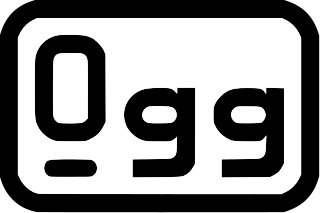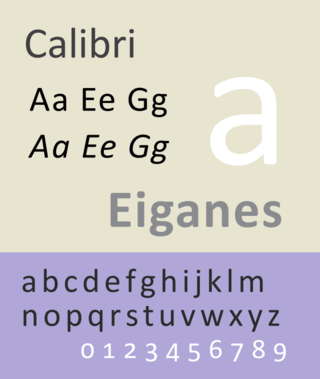Related Research Articles

Ogg is a free, open container format maintained by the Xiph.Org Foundation. The authors of the Ogg format state that it is unrestricted by software patents and is designed to provide for efficient streaming and manipulation of high-quality digital multimedia. Its name is derived from "ogging", jargon from the computer game Netrek.
XyWrite is a word processor for MS-DOS and Windows modeled on the mainframe-based ATEX typesetting system. Popular with writers and editors for its speed and degree of customization, XyWrite was in its heyday the house word processor in many editorial offices, including the New York Times from 1989 to 1993. XyWrite was developed by David Erickson and marketed by XyQuest from 1982 through 1992, after which it was acquired by The Technology Group. The final version for MS-DOS was 4.18 (1993); for Windows, 4.13.
OpenType is a format for scalable computer fonts. It was built on its predecessor TrueType, retaining TrueType's basic structure and adding many intricate data structures for prescribing typographic behavior. OpenType is a registered trademark of Microsoft Corporation.

Vera is a digital typeface superfamily with a liberal license. It was designed by Jim Lyles from the now-defunct Bitstream Inc. type foundry, and it is closely based on Bitstream Prima, for which Lyles was also responsible. It is a TrueType font with full hinting instructions, which improve its rendering quality on low-resolution devices such as computer monitors. The font has also been repackaged as a Type 1 PostScript font, called Bera, for LaTeX users.
In digital typography, the TrueType font Arial Unicode MS is an extended version of the font Arial. Compared to Arial, it includes higher line height, omits kerning pairs and adds enough glyphs to cover a large subset of Unicode 2.1—thus supporting most Microsoft code pages, but also requiring much more storage space. It also adds Ideographic layout tables, but unlike Arial, it mandates no smoothing in the 14–18 point range, and contains Roman (upright) glyphs only; there is no oblique (italic) version. Arial Unicode MS was previously distributed with Microsoft Office, but this ended in 2016 version. It is bundled with Mac OS X v10.5 and later. It may also be purchased separately from Ascender Corporation, who licenses the font from Microsoft.

Courier is a monospaced slab serif typeface. The typeface was designed by Howard "Bud" Kettler (1919–1999). Initially created for IBM's typewriters, it has been adapted for use as a computer font, and versions of it are installed on most desktop computers.

Bitstream Cyberbit is a commercial serif Unicode font designed by Bitstream Inc. It is freeware for non-commercial uses. It was one of the first widely available fonts to support a large portion of the Unicode repertoire.
A computer font is implemented as a digital data file containing a set of graphically related glyphs. A computer font is designed and created using a font editor. A computer font specifically designed for the computer screen, and not for printing, is a screen font.

The writing system of the Korean language is a syllabic alphabet of character parts organized into character blocks representing syllables. The character parts cannot be written from left to right on the computer, as in many Western languages. Every possible syllable in Korean would have to be rendered as syllable blocks by a font, or each character part would have to be encoded separately. Unicode has both options; the character parts ㅎ (h) and ㅏ (a), and the combined syllable 하 (ha), are encoded.
Adobe Type Manager (ATM) was the name of a family of computer programs created and marketed by Adobe Systems for use with their PostScript Type 1 fonts. The last release was Adobe ATM Light 4.1.2, per Adobe's FTP.

Calibri is a digital sans-serif typeface family in the humanist or modern style. It was designed by Luc(as) de Groot in 2002–2004 and released to the general public in 2007, with Microsoft Office 2007 and Windows Vista. In Office 2007, it replaced Times New Roman as the default typeface in Word and replaced Arial as the default in PowerPoint, Excel, Outlook, and WordPad. De Groot described its subtly rounded design as having "a warm and soft character".
Segoe is a typeface, or family of fonts, that is best known for its use by Microsoft. The company uses Segoe in its online and printed marketing materials, including recent logos for a number of products. Additionally, the Segoe UI font sub-family is used by numerous Microsoft applications, and may be installed by applications. It was adopted as Microsoft's default operating system font beginning with Windows Vista, and is also used on outlook.com, Microsoft's web-based email service. In August 2012, Microsoft unveiled its new corporate logo typeset in Segoe, replacing the logo it had used for the previous 25 years.
Terminal is a family of monospaced raster typefaces. It is relatively small compared with Courier. It uses crossed zeros, and is designed to approximate the font normally used in MS-DOS or other text-based consoles such as on Linux. In Microsoft Windows, it is used as the default font in the Command Prompt in Windows 7 and earlier.

Microsoft Sans Serif is a TrueType font introduced with early Windows versions. It is the successor of MS Sans Serif, a proportional bitmap font introduced in Windows 1.0. Both fonts are very similar in design to Arial and Helvetica. This font was made to match the MS Sans bitmap included in the early releases of Microsoft Windows.
TrueDoc was an outline font standard developed by Bitstream that compactly encodes fonts for use in web pages through their TrueDoc system. Embedding a typeface in this way has the aim of eliminating graphics sometimes used in headings or other text, and replacing them by standard text, styled via CSS. The font files are made small by use of subsetting, and only need to be downloaded once. It is a secure method, in that fonts can only be used for the pages they were intended for, and not on other sites, or in other applications.

Bitstream Charter is a serif typeface designed by Matthew Carter in 1987 for Bitstream Inc. Charter is based on Pierre-Simon Fournier’s characters, originating from the 18th century. Classified by Bitstream as a transitional-serif typeface, it also has features of a slab-serif typeface and is often classified as such.
Bitstream Font Fusion is a small, fast, object-oriented font engine written in ANSI C capable of rendering high-quality text on any platform, any device, and at any resolution. The entire source code is portable, optimized, and executes independent of operating system and processor. The font engine is capable of rendering 2,400-3,300 characters per second on a 100 MIPS CPU.

Panorama is a line layout and text composition engine to render text in various worldwide languages made by Bitstream Inc. Panorama uses Font Fusion as the base to support rendering of the text. The engine allows the user to manage different text formatting aspects like spacing, alignment, style effects.

X logical font description (XLFD) is a font standard used by the X Window System. Modern X software typically relies on the newer Fontconfig system instead, but XLFDs are still supported in current X window implementations for compatibility with legacy software.
References
- ↑ PCmag Speedo Definition
- ↑ "Support: Bitstream Speedo Fonts". Archived from the original on 8 November 2009.
- ↑ X.Org: Deprecated in X11R7